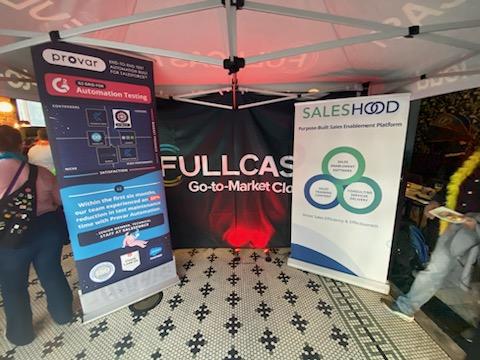Closing the planning to execution loop
Dharmesh: Welcome, Bala. We are live on our first Live Chat for Fullcast to talk about all things to-go-to market planning. Bala, let’s start with letting people hear a little bit about you and how you ended up in sales planning and Fullcast itself?
Bala: I am Bala Balabasakran, co-founder of Fullcast with Dharmesh. We started the company about three years ago to focus on building a revenue operations platform for ops people, allowing them to be more agile, more efficient in the day-to-day business of running a revenue engine, whether that be your sales operations functions, or customer operations.
How did we come about this prior to founding Fullcast? I was at Salesforce, where I ran the Worldwide Field Operations Team and the annual planning process, which is the go-to-market planning process for Salesforce. That was a quite a bit of experience building a set of automations dealing with the practical problems of planning and being able to deliver territories to your salespeople before they go live at the beginning of the fiscal year, but then also continuing to support them throughout the year with moves and changes and all of the daily challenges that most operations teams face. Be it data quality issues in your CRM, people changing roles, people coming into or leaving the business… all of these operational challenges are what my team was responsible for in addition to the almost six-month process of planning the next go-to-market strategy for the next year.
Dharmesh was there with me in Salesforce where we saw a lot of the challenges that ops teams face. Unfortunately, the way that it’s solved very often in the industry is to throw people and bodies at this problem. It’s pretty much just elbow grease and spreadsheets. That’s how this problem has been addressed. We talked to a lot of companies that are in this space wondering what companies like Salesforce and Microsoft do when it comes to sales planning. It is a very multidimensional problem that can get very complex very quickly based on the number of roles, number of salespeople, regions, and all of that stuff.
Before that, I was in a startup. I was mostly on the product engineering side, going all the way back to Microsoft, where I spent time in engineering teams building and architecting solutions that are now part of the Office 365 program.
That is a brief explanation of my experience and how we came about this. Dharmesh, you have a very similar, but reversed, way that you got into sales…
Dharmesh: Yeah, I came from pre-sales consulting, into engineering, into operations.
Bala: We share very similar experiences but from the opposite ends, in a sense.
[4:52] What aspects of plan to execution do companies struggle with?
Dharmesh: Right! So, what do we mean by plan to execution? Specifically, what are the kinds of things that most people struggle with?
Bala: When you look the cycle that most operations teams are involved with, depending on how complex your environment is, for part of the year you’re putting together your modeling; you’re building up what the sales strategy would be for next year. Now, in slightly larger organizations, there’ll be a dedicated set of people for sales strategy that would think about the ways in which you can deploy the right resources into the right markets where you have the best potential to make the most money. Essentially, you have a set of resources you want to deploy that gives you the best ROI at the end of the day.
That’s the sales strategy function. Today, that starts off by extracting a lot of data out of either your CRM or any other systems that may hold information relevant for planning, like your marketing systems, or your HR systems, or your financial systems. You would accumulate all of that and go through this massive cleaning process where you fix the data because it’s never the way you want it. Once you have the data clean, you would then trial out a whole bunch of different models. Do I want to expand in this vertical? Do I want to create a new sales program? Do I want to add a new role to support the sales process?
Questions come about and you play with different models until you settle in on something that you feel is the right approach for next year. You hopefully get that done before the beginning of the next fiscal so that you’re able to give people their quotas, their accounts, and their comp plans and all of that stuff so you get an efficient transition into the new fiscal year.
That’s the process of taking a plan and materializing that for the salespeople that they can go after and go sell and execute that strategy that you put together. For the salespeople, for instance, when they log into the CRM, they see all their accounts and they know what to go after, their strategy, their quota, and what their goals are. So that process is typically handled by a sales operations function; in larger organizations that tends to be a separate team. The strategy teams would have put together the strategy and then hand it over to the operations team to set that up in your transactional systems, such as CRM and your HR systems, so that’s ready for the fiscal year as it starts off.
That’s the initial loop of creating a plan and operationalizing it, into your CRM systems. And this process can be very painful. Today a lot of companies do the strategy in Excel spreadsheets which tend to be a point-in-time copy of the data. Meanwhile, things have moved on in your transactional systems. When you try to put that back into your transaction systems, there’s a lot of challenges associated with it. You’re translating, not just who owns what accounts and things that, but you’re also translating what are the rules of engagement with this new go-to-market model. Where do leads need to get routed to? What’s the operational and sales policies that you have to enforce at run time to keep your execution in line with the strategy that was defined?
[9:30] How are modeling tools used in planning to execution?
Dharmesh: When you say plan to execution, it’s all the stuff that we do in spreadsheets: territories, quotas, who’s covering what. The operationalization of the plan, what we call the execution side, is being done by the ops team generally. I know when we were at Salesforce, for example, we looked at Anaplan. Is that a planning tool? Is that a modeling tool? Why can’t we take that tool and use against execution?
Bala: Anaplan and tools that are modeling tools used to create complex models and to calculate. Instead of doing it in Excel, doing it in Anaplan gives you a lot of flexibility. It’s a multi-user system and scales better than a spreadsheet. That allows you to then build out your models, try out different models, compare models, do all that stuff. But it’s not a platform that you can just operationalize that into your CRM system; that translation still needs to happen, which is where a lot of the issues come about. You have a pristine plan that you can put together in an Excel spreadsheet if Excel is able to handle it or put it together in Anaplan, but you still have to take that model and make it real for the salesperson, and that whole process is still done manually.
While it may help with the modeling aspect of it, it doesn’t help you with the runtime, or the execution side, to allow for this plan to be quickly realized in your sales environment. It’s also a very generic modeling environment, allowing you to model sales models, to financial models, to supply chain models. It’s built in a way that is fairly generic. You have to do a lot of work to build those models. That’s where you would employ the services of a global SI to come in and do that. It’s very similar to building Excel templates; the SI would come in and help you put together what your model is. And the way that we think about it is likely different; Anaplan comes at planning from a modeling perspective.
We think it is very much a purpose-built system, a platform for planning and execution. We know that the biggest challenge with planning is that once you plan, you need to execute it and be able to track progress against the plan. What happens most of the time is you create this great model in Excel spreadsheets, and then you deploy it for the first time and the spreadsheet goes away and there are moves and changes, reorgs, people changing roles, all that stuff that happens throughout the year that never gets reflected back into the plan. You make a lot of assumptions in your plan, such as seasonality, what the ramp looks like… assumptions that never really get tracked in your transactional environment. Very few companies know what the actual ramp is for their employees.
[13:55] How do we close the gap between planning and reality?
Dharmesh: That’s a great segue, because I was thinking about the kinds of things that are stopping people from closing that gap. We spend six months of a year locked up and building a plan only to find out that once we deploy the plan, people have gone, accounts have gone, new accounts are created. What are the kinds of issues that are driving that?
Bala: So, one is the plan itself is going to have the definition of all the roles, who is in them, the territories, account ownership… You can do a bit of that planning, albeit it’s a point-in-time copy of data that you’re doing all that planning in. As you said, when you try to deploy it, things have changed underneath. A great example: scenarios where you want to launch a hunter program and you pick all your prospect accounts three months in advance, and you build out this great hunter program, but by the time you deploy it, some of those accounts have now become customers…
Dharmesh: Or you decided that you didn’t want to have a hunter program anymore because you’re probably doing it in the last quarter anyway.
Bala: That’s a bunch of accounts. Now you have a hunter program with customers in it, which doesn’t make sense. These kinds of issues are quite common when you’re using copies of data in spreadsheets to do your planning. That’s one challenge ops teams deal with; the data that you gave me in the plan is not the same data that we have in the CRM system when I go to deploy it because life has moved on.
That’s one challenge that causes heartache for everybody involved. The second challenge is the reality of bad data. In the planning process, you could assume that there is no bad data.
Dharmesh: Sure, somebody’s cleaned it up in advance for you.
Bala: Exactly, and so you’ve done all that work, but the reality is you have to live with bad data. What I mean is, it is an inherent fact in most CRM systems that net new accounts get created in the system and we don’t have enough data on that account to match it up to a corporate family to know if it is an enterprise account versus a mid-market account versus an SMB account.
Dharmesh: How do companies deal with it today? We have data providers in the market, we have demand tools to clean out accounts. Why don’t those solutions work?
Bala: I’ll address that question in a second, but that’s one of the other challenges with your previous question about dealing with bad data, because it is just going to happen. Implementing a plan on top of that data is a challenge for most ops teams to deal with, especially when you haven’t defined what the policy is.
The third scenario is where you have a lot of point solutions. I call it that because these may be specialized solutions solving one aspect of your sales motion or your go-to-market motion. As an example, you may have a system that does your routing. You may have a system that you build some automation that does your protocol tagging or hold-outs or whatever those operational challenges are. You have built or bought a bunch of point solutions. The more of those you have, the higher your inertia for change is. Any time you need to deploy a new go-to-market model, you not only have to deploy the data, but you also have to go in and touch each of these applications, change the routing rules in one system, change the hierarchy rules in another, change the hold-out rules… and not all of this is data-driven. A lot of times you have to engage the IT team to make changes in the code that is deployed in your Salesforce or hire a consultant to implement the go-to-market model. This is already on top of your day-to-day job of running an ops function, a day-to-day job of running your IT organization. This adds up into a huge backlog of issues! We find it takes four to eight weeks before some of these things are implemented. Just going from your strategy that was on an Excel sheet to actual runtime could potentially take four to eight weeks.
Dharmesh: So, you build a plan in Anaplan or some other tool; you pull data out of Salesforce, or load into an Excel sheet, clean up the data, do your plan, give it to IT, wait for them to do data loads… And then that’s when they find all the issues. You clean it up, re-factor the plan, re-send it back, find some issues… And then you probably load it and make some changes which probably never get transferred back into this Excel spreadsheet.
And then the things that you mentioned, things like holdouts and all… I don’t think anybody ever tracks them anywhere! And then of course, all the duplicate stuff that you mentioned, account hierarchies never get informed into the plan.
Bala: This pain is really… when we say planning to execution, we’re not just talking about data loading your plan into your CRM. There’s a bunch of things that you have to do in order for all of those things to work out. And then you have regulatory compliance requirements in terms of making sure your salespeople get their comp plans in time, their quota assignments, their list of accounts…
[20:42] What about dating and covering accounts? Is that planning or execution?
Dharmesh: I’m not sure how many people realize it, but companies are legally required to get a comp plan in a short duration. I’ve seen when you don’t get territories assigned in time, people don’t know what the quota is, and it’s just a classic piece. But another issue is that people are sensitive to comp itself. Do you talk about effective dating of people and covering as part of execution or part of planning?
Bala: No, that’s part of execution. Because with the changes that happened throughout the year, you need to be able to audit exactly who was on the account at the time the deal closed…
Dharmesh: …and that is done by the field operations teams, mostly…
Bala: That is done by mostly the operations teams; they have to track it and be able to support queries that they get from the sales team when their comp checks are issued. “My spreadsheet says this and how did you get to this number?” You get queries that you must be able to track, report on, and clarify for the sales team. Salesforce is a transactional system, which means it is not great at maintaining effective data history. You can’t pull up an account and say, okay, who covered this in January of 2020? Unless you turn on history tracking, which has its limitations. So, those are some of the challenges.
Dharmesh: I just want to be clear: When you talk about sales, are we talking about all go-to market resources, including folks in account management or customer success who might be covering an account? When you talk about planning to execution, you’re talking about the entire spectrum?
Bala: Correct, that is a good call-out. In the past, it used to be siloed organizations; you have a customer ops team, a sales ops team, and so on. When you deploy a plan at the beginning of the year, it tends to be very heavy on the sales side, but the customer ops teams also need to do the same. Over the last few years, the emerging principle of revenue ops is: How do you bring all of these disparate operations teams into a coherent operations environment so that you can execute on that go-to-market motion?
In the SAS world, a sale is a right to earn money; it’s not the money itself. When you do a sale, the idea is that you’ve just made a contract. You still have to deliver the service in order to earn the money that you signed up for. It’s very different from the old world of sales, which was that when you sold it, you made the money and you were paid commission and you were happy. Not anymore! That model has changed, which means that the customer operations side of the house is just as important for revenue generation as is the sales side.
[24:38] What kinds of shifts in planning are we seeing today?
Dharmesh: Two questions: When you work with companies now, are you seeing them bring the two together into one organization? And secondly, planning historically has been seen as an annual event. People feel they can do it one time. Are you seeing that shift from an annual cycle to a shorter cadence? Why is that happening?
Bala: To answer your first question: You’ll see the title Chief Revenue Officer in organizations today. Usually that means all of the distribution functions are under one leader: marketing, sales, and customer success. Whenever you see that, it’s a great indication that the company is thinking about revenue as this end-to-end distribution function, and that’s a perfect environment where the ops functions will naturally coalesce into this one operations environment and discipline. We’re seeing that in a lot of our customers, especially SAS companies tend to lead that charge. But we’re seeing that happen with the new business models, SAS driving a lot of the business.
To answer your second question, there are multiple levels of planning. When you think about the annual cycle, what tends to happen there is a lot of aspects are driven by the financial planning cycle. In the financial planning cycle, your CFO goes through their annual process of budgeting and creating the financial plan for next year. Especially if you’re a public company, you have commitments to do that on a regular basis. When you define that financial model, there are inputs from that model that are important for sales, such as your expense envelope and your annual revenue target. Here’s what the company is committing to from a revenue perspective and here is the budget we can allocate in order to maintain the margin numbers and all that stuff that we need for the financial liability of the company. Those become inputs into the sales planning process. You take that expense envelope and the revenue target that finance lays out, then break that down into, “How many people do I need to hire? What roles do I need to hire them? In what accounts do I give them? Which markets do I go into? What’s giving me the most ROI for how I want to deploy that expense envelope?”
That exercise is a follow-on from the financial model. You may not do financial recasting every month; you probably do that every quarter at the most. But they tend to be a lot more stable in terms of volatility, because you want to show that the company has projected out what next year’s performance would look like. There needs to be stability. But when you translate that into sales, now you’re adding a lot more variables, people, and roles. How many people are you going to hire? Where are you going to hire them?
So all of that translation, unfortunately, is not static because people change, the market conditions change, and your ability as a sales organization to respond to those market conditions is what allows you to be successful. Your ability to say, hey, we tried out this new sales program, that’s not working, let’s reorganize it and let’s go over here. Being able to respond to the market in that way is what allows sales teams to be successful. The flexibility that sales managers have to be able to deploy the resources and in the capacity on. That flexibility means that this exercise of planning, which territory, which accounts, which people in what roles… is almost a continuous thing.
Dharmesh: Do you think companies are planning every three months now? Or updating plans?
Bala: Or we need to think of it as continuous planning, not necessarily a time frame associated with it…
Dharmesh: That’s an important point. I can’t change my field coverage and people in the field on a continuous basis. When you say continuous planning, you’re saying you plan continuously, but you choose to make execution changes on whatever time cycle that you might want?
Bala: That’s right. When we say plan continuously you are planning for where things are working and where things are not working. It doesn’t always mean an entire overhaul of everything that you did at the beginning of the year. It means tweaks everywhere. We organize one business unit, you may move certain people into certain roles, rearrange the structure of the roles, rearrange how people get leads… all of these things are micro-changes that you will continue to make to your plan, to optimize it for the market condition that you’re seeing. COVID is a great example of something in the market that nobody had control over, but every company has to figure out how to respond to it, right?
[30:39] How is COVID affecting planning to execution?
Dharmesh: How are your customers planning now?
Dharmesh: Everybody has to recast everything now. With COVID, they have to look at what the impact is now. Companies are doing really well. This is a great opportunity for some companies that service essential services. Other companies are struggling. COVID has essentially shifted the purse from one set of companies to another set of companies. Some companies are recasting for growth. Some companies are recasting for a reduction. Two months later, if everything opens up again, we’ll have to change. You have to readjust.
Dharmesh: Thinking about COVID… let’s say I want to redo segments. I want to create more micro-segments. Those are the kinds of things that you would do on the planning side and be able to execute against. This is what you’re seeing when you talk about shortening the cycle and doing continuous planning, is that essentially what you are doing?
Bala: You can identify what sectors are growing and what sectors are contracting. You would ideally want to deploy your salespeople in areas where there is growth. If you look at somebody’s territory and decide to divide it up by verticals — we’re going to put more people into these verticals that are doing well versus these verticals where there is not a lot of action happening… that’s a real adjustment of people to territories, to accounts, to verticals that you can see, okay, let’s go after that.
Another situation be that, now that people are cooped up inside, you have a lot more inbound coming in where you might not have had that in the past, People are going to websites and coming inbound versus a face-to-face call. That shifts how you handle leads. You might put more people to handle leads in a way that works. These kinds of micro-adjustments, you’re going to be able to do… but there are tons of micro-adjustments that will happen.
Dharmesh: We know that. for as long as companies have had sales, they’ve done some sales planning. We now understand all the kinds of things that get in the way of closing the loop. If you were to work with someone today, what are the kinds of things you would say companies should look at doing to shorten that gap? How should companies look at investment plans? For example, is it good to have the ability to plan? Or is it a necessary investment, especially now in this environment? How can teams do more with less? How would you advise them?
Bala: That’s the premise of Fullcast; that’s really what we try to do. There are a few challenges. One is you want to be responsive to the sales team. As an ops function, your agility is key.
Dharmesh: Sales guys don’t care what the ops guy’s life is!
Bala: No, they don’t! And most sales managers know that somebody is preparing the strategy, somebody’s working on the ops function, and you have a nice little report on your desk on Monday mornings that you can look at. They don’t know what it takes to pull that together. Most sales managers will realize that there is an ops problem only when things don’t work, not when things are working.
Agility is important for an ops function. If you look at investment, then the investments need to go into those scenarios which allow the ops function to respond in an agile manner to the requirements of the sales team. You cannot solve that by throwing more people at it, however hard you try. Automation is the only way to address that issue. To really tackle that problem at scale, it’s not hiring 10 more people. Especially in a situation like COVID, you’re not getting the 10 more people head count from an ops perspective, it’s better to deploy those 10 into sales than it is to deploy that into operations.
So, most ops teams that I know of are already operating, even in the non-COVID scenario, on a constrained budget. Because ops functions need to have some control of how much is spent on the revenue dollar. For every dollar in revenue that’s generated, you have to control how much ops you’re putting into it. There is already some ceiling or controls that most CFOs would put in to make sure that the ops functions don’t go crazy because that’s an expense that cuts into your margin. With that constraint, you cannot assume that you can just scale this by throwing bodies at this problem — that just doesn’t work! You will end up burning out people and it’s not a very happy or a high-satisfaction role.
The only way to solve that is through automation. So, what do you automate? You need to automate the responsiveness of the ops function to the requirements of the sales team, whatever those requirements are.
[37:45] What are sales leaders looking for in automation?
Dharmesh: So, going back to the beginning, you’ve supported a variety of sales leaders and they had an idea of what they wanted from ops. They think, just get it done. I don’t want this noise; I don’t want to be spending time in this. I have a case in mind, which is a field ops escalation we used to have at Salesforce. That’s a scenario that I used to hear execs complain about spending time on. What would be some of those things that you would say sales CROs say that they would love to see automated? What do they expect a sales operations team or sales strategy team to be driving?
Bala: If you look at the spectrum of things that a sales operations team does, the most valued aspect of sales operation is getting the type of data you want to make the decisions you want to make. Clean data. Insights that you’re providing to the sales leader, or revenue leader, that shows where the problem spots are and predicts challenges. Very few ops teams are in that realm.
Dharmesh: Well, why not? I mean, you’ve got a proliferation of tools today: Salesforce, Einstein, and Clary… don’t they close the gap?
Bala: They close the gaps in certain areas. If you use a solution like Clari for forecasting and you have all the data that you need in order to make Clari successful, you have data quality issues addressed, then you get better forecasting numbers. But what you don’t think about is the fully ramped Account Executive in this territory just left, and we have much deal in the pipeline. What would be the response to that event? Do you put somebody else in? What is the ramp time that’s involved? Do you hire somebody new into that territory given what’s going on there?
So, being able to deal with it at that level — not just “What is my number going to be next month?” It’s, “How do I hit that number? What are the changes? What is the deployment?”
Dharmesh: Well, a big assumption you made is that Clary, or Einstein, or whatever reporting deal that you have, has access to pristine data, which is rarely the case.
Bala: Well, I mean, even if it’s not pristine, it’s high-quality data. The ops teams have to do a lot of work to make sure that a high quality of data is delivered to this AI machine learning environment that can then predict with a level of accuracy. That’s a tall order by itself. That is value, if we can achieve it, that is appreciated by the revenue leader. Most operations teams struggle with that. Any sales leader that you ask wants more, better forecasting solutions. But it doesn’t magically happen; it needs to have data.
Dharmesh: Tyler did a good talk on all the data issues last week.
Bala: That’s one thing. The second thing is these micro-events and their impact on your plan, which means I’m now going to have to put somebody else in there. Who’s the best person to put in there? How much ramp time is that person going to take? What’s the impact of that ramp on the number in that territory? How is that going to impact the overall number? That intelligence is something that would be highly valuable to a sales leader. If an ops team can get to the point where you’re giving the sales leader that forward-looking intelligence, that is the most valuable thing teams can do.
Secondly, it’s the smooth operations of the daily business of sales. I’ve got new hires coming in. Do they get their territories on time? I’ve got people that have changes in roles, there are people that are leaving the business. Are those accounts getting covered appropriately? Nobody notices this stuff until it breaks. Until a rep complains to the CRO, “I haven’t had my territory for two months,” the CRO doesn’t know. This is needed in a large organization.
[43:00] Why do teams struggle to keep up with changes?
Dharmesh: Why do teams struggle with that stuff?
Bala: It’s the backlog! It’s not that they’re not efficient or working hard. In fact, they’re burning out, in most cases! It’s just this backlog of manual stuff that gets built up over time that most teams struggle to keep up with. You can’t continue to tackle that with people; you have to automate to reduce that backlog and almost eliminate it. If you can, this problem goes away. But that takes a specific set of automations in place to do that execution part. Whenever those plan changes occur, you need to be able to execute them very quickly. That translation is why a lot of ops teams struggle with keeping up and start to build up a huge backlog of issues. They’re working as hard as they can trying to get through it, but when you’re scaling, you can’t keep up.
You can throw bodies at it. But as we talked about, there is a ceiling. Then four weeks of waiting has to occur before the team is able to get to the problem that the sales team won’t solve. Four weeks is a long time in sales, especially when you’re closing deals very quickly. One very common problem: If cleaning of data doesn’t occur very quickly, an SMB Rep may close a deal on a subsidiary of an enterprise account, which may be not what your plan is. It creates its own challenges because you’re not able to keep up.
With data quality issues, reps start to complain. This is something I tell my ops teams all the time: Everything that an ops team does has emotion attached to it. This is people’s livelihoods; you can’t just take accounts away from people or close up opportunities. This is how they make money, which means there’s emotion attached to it. So, there is a lot of complaining and pain that comes out of it. That pain is what most sales leaders see, not the fundamental problem that’s causing that pain. What they see is the pain and say, well, why don’t you run faster? Why don’t you close this faster? You can’t close this faster because the backlog is ever-increasing.
You get ops teams that get caught up in this cycle. The sad part is… it’s like a toad getting cooked slowly — it doesn’t notice that it’s getting cooked. People tend to focus on running faster versus stepping back and saying, no, we’ve got to take an entirely different approach to how we go about this problem.
This requires a different level of automation, rather than running faster. It reminds me of you know Henry Ford saying, “If I went out and did a survey and asked people what they wanted, they would’ve said ‘faster horses.’” Most ops teams will tell you, “Make me go faster in this thing because that’s what I have to do today.” That’s addressing the symptom rather than the main problem, which is this translation from planning to execution. You have to be able to automate that in order to achieve that agility that you want as an ops team.
Dharmesh: Excellent, this has been a great session. Any parting thoughts on how somebody who’s leading an organization… well, as you said, he should not be going with the Henry Ford lens. How should they be thinking?
Bala: The most important thing is to stop, step back, and look at the problem holistically. It’s not just a planning problem. It’s not just a data quality problem. It’s not just a quota problem. It’s not just a commissioning problem.
If you open your inbox, you will see all these complaints about things that are not working well. They’re not working because they are an interconnected set of things that need to happen. It connects between planning, to commissions, to data call. All of those things are interconnected and impact each other. It’s important to step back and look at the problem holistically rather than trying to put Band-Aids on symptoms. That’s the best advice that I could give.
Every change, every move, every adjustment that you make has an impact somewhere else, you just don’t realize what that impact is if you’re not thinking about it holistically.
Dharmesh: Excellent, thank you! If you’re interested, we can talk about the Fullcast platform or any topics you want. Thank you, Bala!
Bala: Thank you, Dharmesh!











